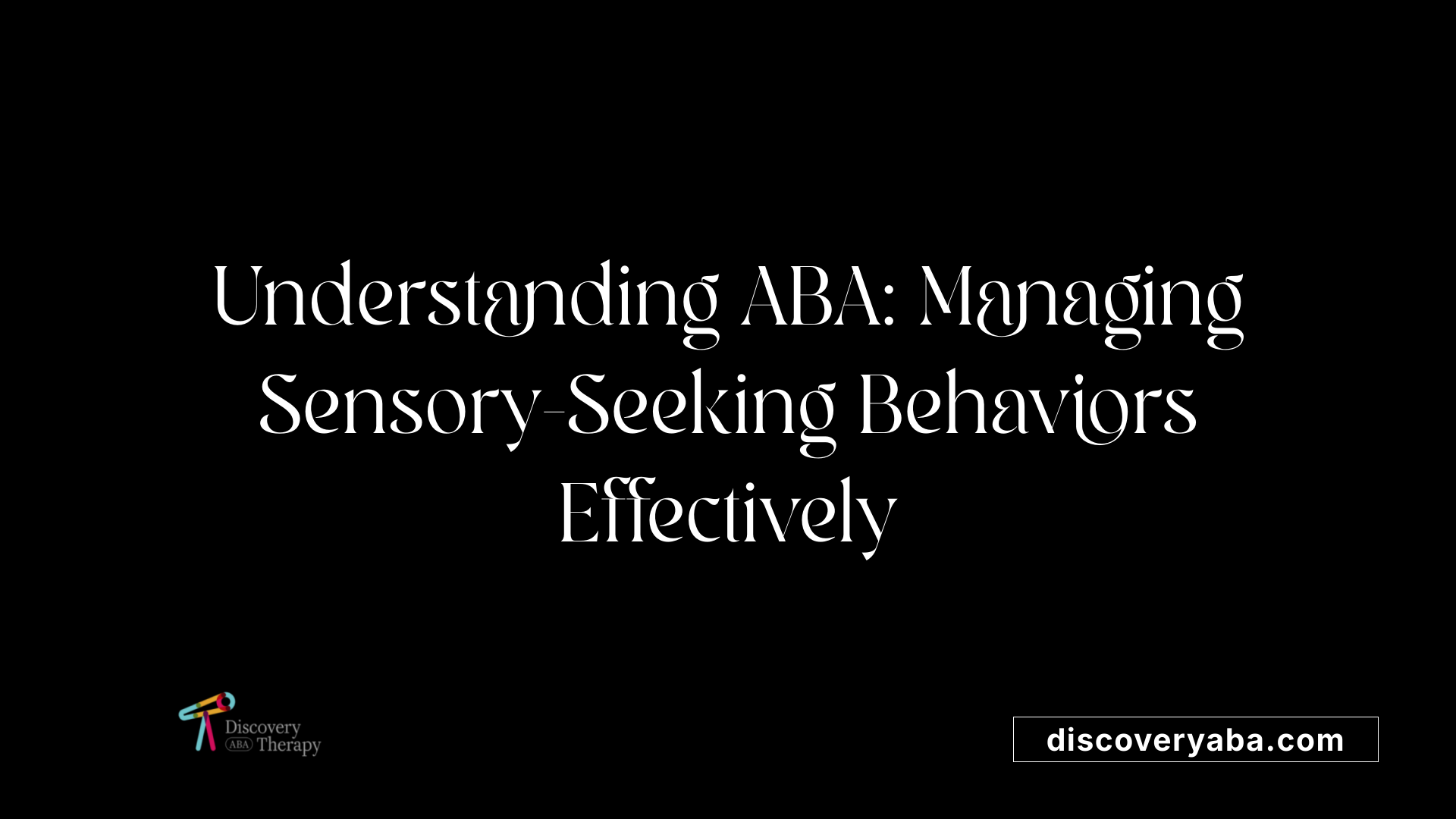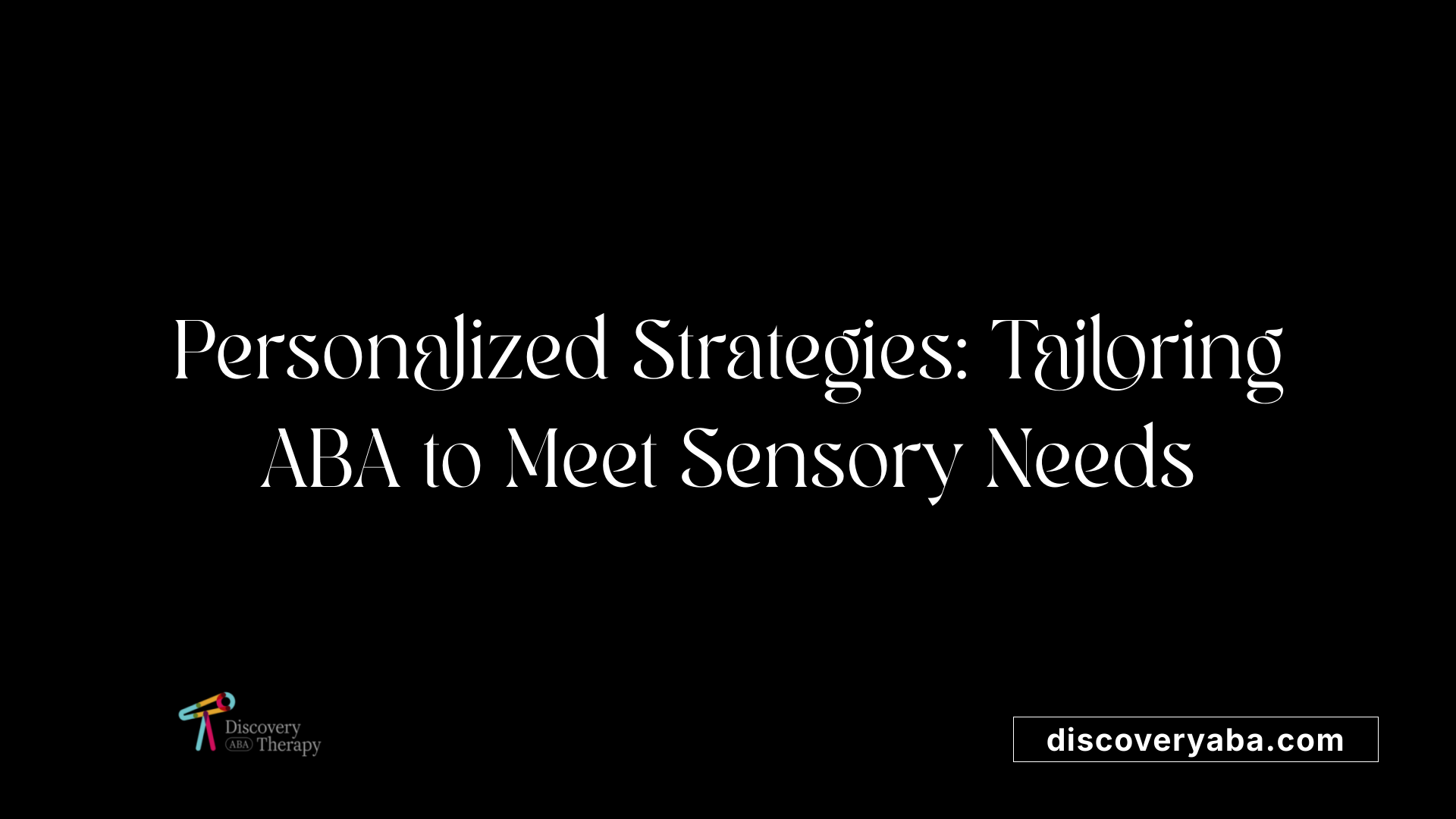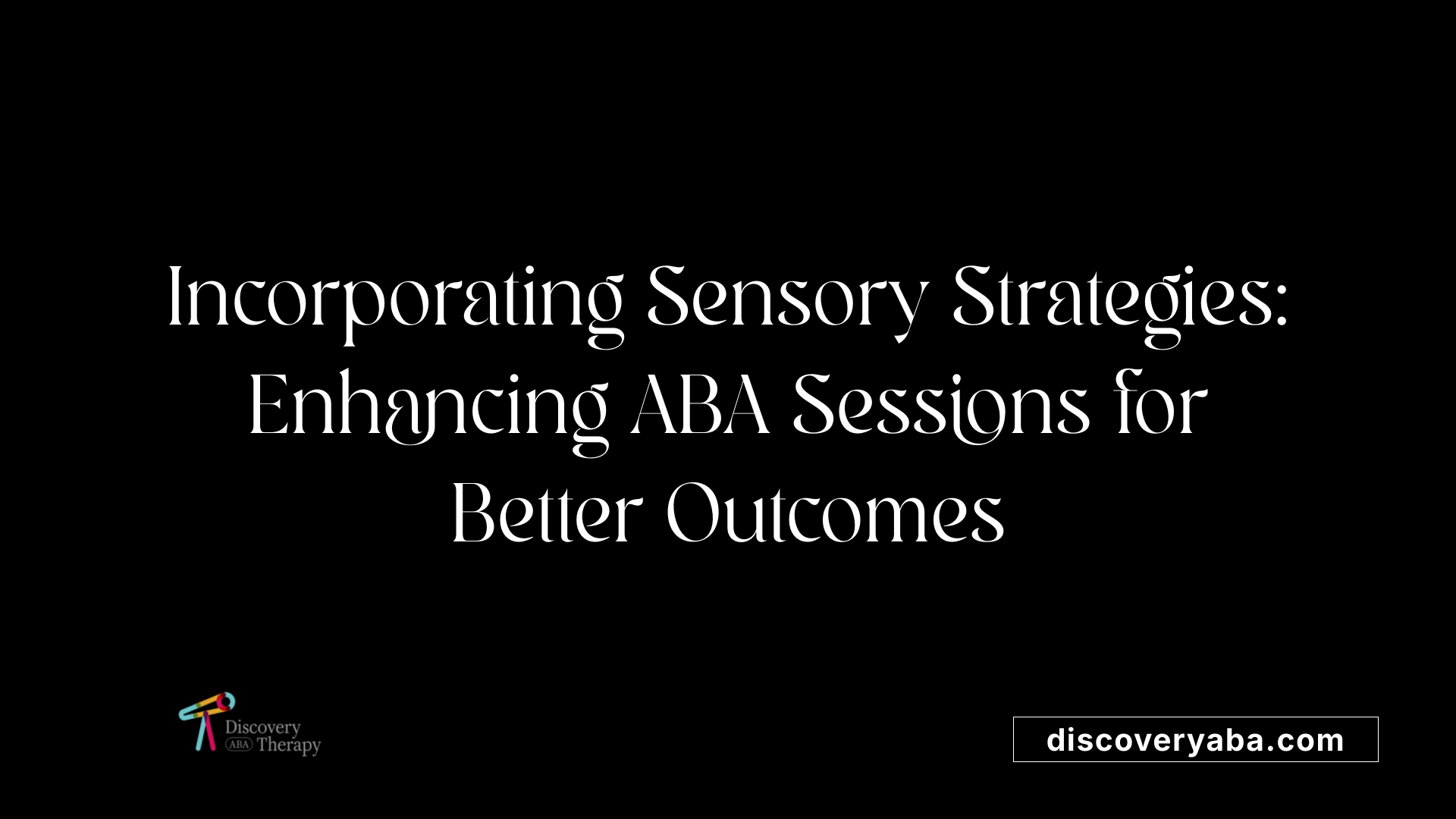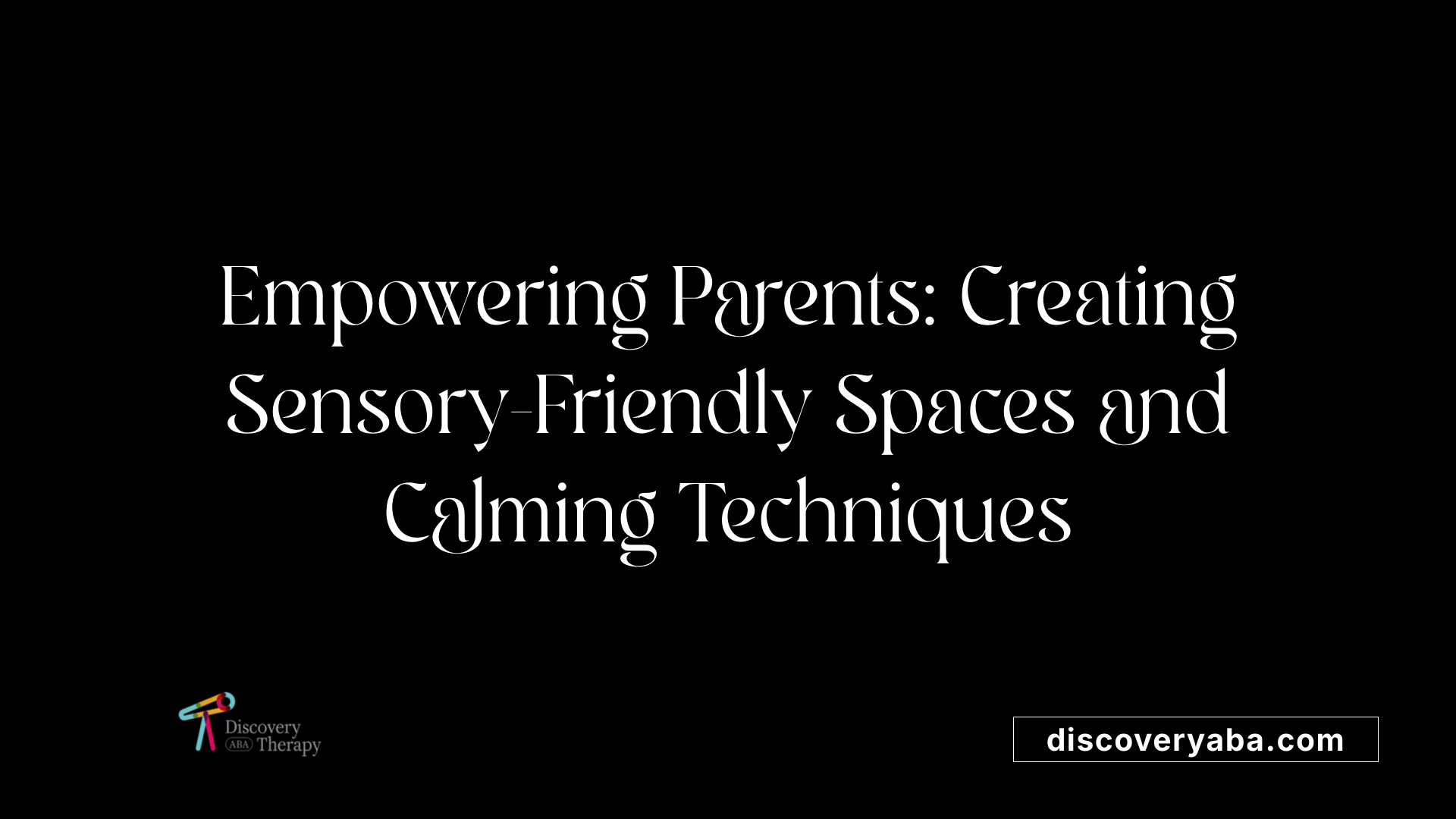Using ABA to help with sensory-seeking behaviors
Effective Strategies for Managing Sensory-Seeking Behaviors with ABA

Understanding Sensory-Seeking Behaviors in Children with Autism
Children with autism often exhibit sensory-seeking behaviors as a response to hypo-responsiveness to sensory stimuli. These behaviors, which may include fidgeting, repetitive motions, or seeking out loud noises, are attempts to self-regulate and satisfy sensory needs. Addressing these behaviors is crucial for promoting better emotional regulation, social participation, and overall development. Applied Behavioral Analysis (ABA) offers a structured, science-based framework to help manage and channel sensory-seeking behaviors into positive activities, fostering independence and reducing problematic actions.
The Principles of ABA in the Context of Sensory Behaviors

How do ABA principles apply in managing sensory-seeking behaviors?
Applied Behavioral Analysis (ABA) is a science-based approach that focuses on understanding and changing behavior by analyzing its function. For children with autism and sensory processing differences, ABA helps manage sensory-seeking behaviors—actions driven by the need for additional sensory input, such as fidgeting, mouthing objects, or repetitive movements.
ABA practitioners observe the antecedents (triggers) and consequences (outcomes) of these behaviors to determine their purpose. For example, a child might seek movement to self-regulate when overwhelmed. By understanding this, therapists can develop tailored interventions.
Reinforcement strategies are at the core of ABA. Instead of allowing potentially harmful sensory seeking, children are taught to ask for breaks or engage in acceptable activities like swinging or using sensory toys. Techniques such as differential reinforcement highlight desirable behaviors—rewarding appropriate sensory activities while reducing problematic ones.
Shaping and modeling are also used to gradually teach children alternative ways to meet their sensory needs. Deep pressure, weighted blankets, or sensory diets can be incorporated into routines, helping children tolerate sensory input without distress.
Overall, ABA provides a structured way to replace disruptive sensory-seeking behaviors with functional, adaptive responses that support learning, safety, and emotional regulation.
What is the role of ABA in sensory integration and related interventions?
ABA contributes significantly to sensory integration by creating interventions that improve how children process and respond to sensory stimuli. While sensory integration therapy traditionally involves activities like tactile play, vestibular exercises, and auditory tasks, ABA adds a behavioral component to reinforce adaptive responses.
This involves identifying specific sensory triggers—such as noise levels or textures—that cause distress or seeking behaviors. Therapists then apply positive reinforcement to promote calm and appropriate responses. For instance, a child who avoids noisy environments might be gradually exposed to auditory stimuli paired with rewards.
The integration of sensory strategies within ABA—sometimes called 'sensory integration ABA'—strengthens the child's ability to adapt to sensory input, enhancing self-regulation and participation in daily activities. This holistic approach is particularly effective for children with sensory processing disorder (SPD) or autism, as it addresses both behavioral and sensory challenges simultaneously.
Collaborative work among occupational therapists, speech-language pathologists, and ABA therapists helps design personalized programs. These programs include sensory activities like brushing, sensory bins, weighted items, and environmental modifications to support consistent and effective intervention.
In conclusion, ABA plays a pivotal role in facilitating sensory integration by reinforcing adaptive behaviors, reducing sensory overload, and improving overall emotional and behavioral functioning.
Assessment and Customization of ABA Interventions for Sensory Needs

What techniques and strategies are used in ABA to address sensory-seeking behaviors?
ABA therapy considers sensory-seeking behaviors—where children actively look for sensory stimulation—by implementing a variety of targeted techniques. These include positive reinforcement, prompting, modeling, and chaining that help children learn suitable, adaptive behaviors as replacements for risky or disruptive ones.
A core element is gradual desensitization, which involves carefully exposing children to sensory stimuli in controlled ways to increase their tolerance over time. This approach is often paired with sensory diets—structured activities like swinging, deep-pressure massage, or the use of sensory toys—that are tailored to each child's preferences and sensory needs.
Environmental modifications play a crucial role. Creating sensory-friendly spaces with items such as textured toys, weighted blankets, or calming lighting minimizes triggers and encourages self-regulation. Academic and behavioral strategies also incorporate teaching children coping mechanisms such as deep breathing exercises, visual supports, or scheduled sensory breaks, empowering them to manage sensory overload.
Effective intervention relies on ongoing assessment using tools such as functional behavior assessments (FBA) and direct observation. These assessments identify specific sensory triggers and preferences, enabling therapists and caregivers to adjust strategies accordingly. Ultimately, the goal is to foster emotional regulation, improve social skills, and enhance overall participation in daily activities through personalized, evidence-based practices.
Incorporating Sensory Strategies within ABA Sessions

What techniques and strategies are used in ABA to address sensory-seeking behaviors?
ABA (Applied Behavioral Analysis) employs a variety of methods to help children with autism who display sensory-seeking behaviors. These techniques include positive reinforcement, prompting, modeling, and chaining to teach children appropriate ways to seek sensory input. For example, a child might be reinforced for engaging in safe, self-regulated sensory activities like squeezing a stress ball instead of mouthing objects or engaging in risky behavior.
Gradual desensitization is used to help children build tolerance to stimulating sensory input, with personalized sensory diets designed to meet individual needs. Environmental modifications, such as creating sensory-friendly spaces and providing sensory toys, help minimize triggers and support self-regulation.
Supporting strategies extend to teaching children coping mechanisms like deep breathing, the use of visual supports, or scheduled sensory breaks, which can decrease the likelihood of problem behaviors stemming from sensory overload. Continuous assessment, including Functional Behavior Assessments (FBA) and direct observations, ensures interventions are tailored to each child’s sensory preferences, aiding in emotional regulation and improving social engagement.
These integrated approaches allow children to develop more adaptive responses and participate more comfortably in daily activities, promoting overall growth and independence.
Implementing Reinforcement and Replacement Behaviors
Use of positive reinforcement like verbal praise, tokens, or tangible rewards
In ABA therapy, positive reinforcement is a foundational strategy used to encourage desired behaviors. For children with autism, rewards such as verbal praise, tokens, or tangible incentives help solidify positive actions. When a child exhibits a behavior that is beneficial—such as engaging with sensory toys in a calm manner—they receive immediate praise or rewards. This immediate feedback strengthens the likelihood that the behavior will recur.
Tokens can be accumulated and exchanged for larger rewards, motivating children to practice newly learned skills consistently. Tangible rewards, like favorite snacks or toys, are also effective, especially when aligned with the child’s preferences. Reinforcement is personalized to ensure it resonates with each child's unique motivators.
Teaching functional replacement behaviors
Beyond encouraging positive behaviors, ABA emphasizes teaching children alternative, functional skills—known as replacement behaviors—that serve the same purpose as undesired actions. For example, if a child screams to seek sensory input, a therapist might teach them to use a calmer signal, such as handing over a sensory toy or using a visual choice card. These replacement behaviors enable children to meet their sensory needs in a more appropriate way.
Implementing these behaviors involves step-by-step instruction, modeling, and consistent practice. Over time, children learn to channel their sensory seeking or avoiding behaviors into adaptive responses, reducing problematic reactions and improving overall functioning.
Differential reinforcement and shaping techniques
Differential reinforcement involves providing rewards for specific desired behaviors while withholding reinforcement for less desirable actions. For instance, a child might be reinforced for using a calming method during sensory overload instead of engaging in a meltdown. This method helps highlight and strengthen positive coping strategies.
Shaping builds on this concept by rewarding successive approximations toward the target behavior. For example, if a child needs to tolerate more sensory input, reinforcement might initially be given for just noticing a stimulus, then for remaining calm during brief exposures, and eventually for engaging in sensory activities calmly for extended periods.
Both techniques are dynamic tools that adapt to the child's progress, gradually guiding them toward more appropriate behaviors for managing sensory challenges.
How ABA techniques address sensory-seeking behaviors
ABA addresses sensory-seeking behaviors through a combination of techniques such as positive reinforcement, prompting, modeling, and chaining to develop appropriate replacement behaviors. Gradual desensitization and sensory diets are used to help children build tolerance to sensory stimuli, often with personalized activities and positive reinforcement to encourage adaptive responses.
Environmental modifications, like creating sensory-friendly spaces and providing sensory tools, help reduce triggers and support regulation. Teaching coping strategies such as deep breathing, visual supports, and sensory breaks allow children to manage overwhelm effectively.
Ongoing assessment, including functional behavior assessments and direct observations, ensures that interventions are tailored to each child's sensory preferences and needs, promoting emotional regulation and social participation. This holistic approach increases the child’s ability to navigate sensory experiences more comfortably, leading to improved behaviors and social interactions.
Parent Training and Creating Sensory-Friendly Environments

How can parents and caregivers be guided on sensory triggers and calming techniques?
Parents and caregivers play a crucial role in supporting children with autism who experience sensory sensitivities. To do this effectively, they need access to educational resources designed to inform and empower. Many organizations, such as Autism Speaks, provide comprehensive guides like their Parent's Guide to ABA, which explains sensory sensitivities and presents practical approaches for managing them.
These resources often include strategies such as identifying specific sensory triggers—like loud noises or bright lights—and teaching calming techniques like deep breathing exercises, visual supports, and sensory breaks. Visual schedules, noise-canceling headphones, and quiet spaces are commonly recommended tools for creating calming environments.
Workshops, webinars, and individualized training sessions led by ABA therapists or occupational therapists equip parents with skills to recognize signs of sensory overload and implement immediate calming strategies. Educational videos, podcasts, and blog articles are also valuable for ongoing learning.
By understanding their child's unique sensory profile, parents can respond promptly and adapt routines to prevent overstimulation, fostering a more comfortable and supportive environment for daily activities.
Conclusion and Future Perspectives
Summarizing the importance of ABA in managing sensory-seeking behaviors
Applied Behavioral Analysis (ABA) plays a significant role in helping children with autism, especially those exhibiting sensory-seeking behaviors. By implementing strategies rooted in behavioral science, ABA therapy focuses on reinforcing positive behaviors and replacing problematic ones. Techniques such as positive reinforcement, functional behavior assessments, and structured activities allow children to learn appropriate responses to sensory input. Incorporating sensory integration strategies into ABA can help children experience sensory stimuli safely and comfortably, reducing behaviors that may be harmful or disruptive.
Integrating sensory techniques within ABA—often called 'sensory integration ABA'—addresses both behavioral challenges and sensory processing issues. This combined approach not only improves emotional regulation and social interactions but also promotes greater independence. Sensory-seeking behaviors, characterized by movement, tactile exploration, or loud stimuli, are often linked to under-responsiveness in the sensory system. Managing these behaviors through engaging activities like jumping on trampolines or using sensory toys can prevent harm and foster positive development.
Encouraging ongoing parent and caregiver involvement
Active participation from parents and caregivers is crucial in the success of ABA interventions, especially when managing sensory-seeking behaviors. Training parents to recognize sensory triggers and use reinforcement techniques at home ensures consistency and reinforces skills learned during therapy sessions. Collaborating with therapists helps create sensory-friendly environments in daily settings—home, school, or community—that support ongoing progress.
By understanding and addressing sensory needs, caregivers can incorporate calming strategies such as sensory tools, quiet spaces, and tailored activities. This support helps children build confidence in managing sensory input and reduces anxiety or meltdowns. Ongoing education and communication between families and professionals foster a holistic approach, ultimately making therapy more effective and sustainable.
Highlighting the need for continued research and individualized interventions
While current evidence underscores the effectiveness of combining ABA with sensory integration strategies, there remains a vital need for ongoing research to refine these approaches. Recognizing that each child's sensory profile and behavioral responses are unique underscores the importance of personalized intervention plans. Advances in technology and neuroscience can provide deeper insights into sensory processing and help develop more targeted therapies.
Moving forward, future research should explore how varying sensory sensitivities influence behavior and how interventions can be tailored to suit diverse needs. The development of new tools and techniques—such as wearable sensory devices or virtual reality-based therapies—may enhance engagement and outcomes.
In conclusion, the future of ABA in sensory behavior management lies in its adaptability and partnership with other therapeutic modalities. Emphasizing personalized care, ongoing caregiver involvement, and scientific innovation will be essential in optimizing interventions. Together, these efforts will ensure that children with autism receive the support they need to navigate sensory challenges, thrive socially and emotionally, and gain independence in their daily lives.
Empowering Families and Enhancing Treatment Outcomes
In conclusion, ABA offers a versatile and effective approach for managing sensory-seeking behaviors in children with autism. By incorporating a variety of techniques such as sensory diets, positive reinforcement, environmental modifications, and sensory integration strategies, ABA helps children learn adaptive responses that improve their emotional regulation, social skills, and independence. Parental involvement and caregiver training are crucial components, enabling families to reinforce strategies at home and create sensory-friendly environments. As research advances, continued innovation and personalized interventions will further enhance the effectiveness of ABA, supporting children’s developmental trajectories and improving quality of life. Collaborative efforts between therapists, families, and educators are essential to achieve lasting and meaningful progress, paving the way for a future where sensory challenges are effectively managed through holistic and tailored approaches.
References
- 6 Ways To Help Sensory Seeking Behavior In Kids | Circle Care
- How Does ABA Therapy Help With Sensory Processing?
- How ABA Supports Children with Sensory Issues?
- Sensory Processing: A Key Aspect of ABA Therapy
- All You Need to Know About ABA and Sensory Integration Therapy
- How ABA Therapy Complements Sensory Integration Therapy
- Sensory Seeking vs Avoiding - Lighthouse Autism Center
Does Your Child Have An Autism Diagnosis?
Learn More About How ABA Therapy Can Help
Find More Articles
Contact us
North Carolina, Nevada, Utah, Virginia
New Hampshire, Maine
Arizona, Colorado, Georgia, New Mexico, Oklahoma, Texas
.avif)




































































































